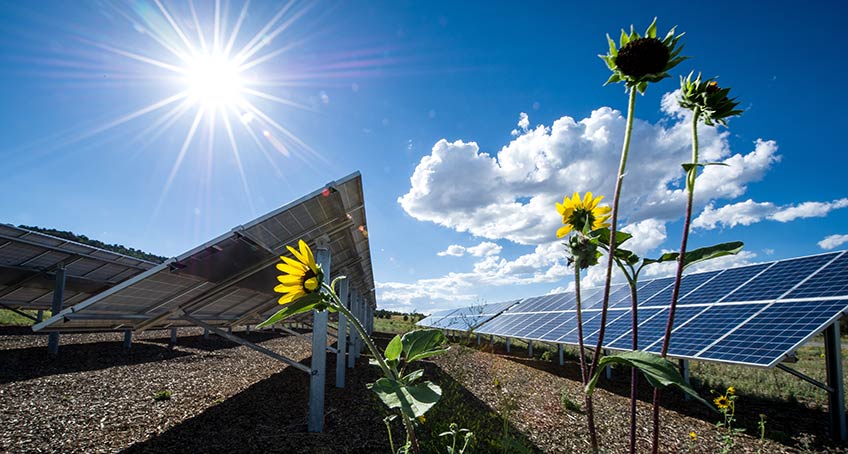Solar Photovoltaic Technology Basics
Solar cells, also called photovoltaic cells, convert sunlight directly into electricity.

Photovoltaics (often shortened as PV) gets its name from the process of converting light (photons) to electricity (voltage), which is called the photovoltaic effect. This phenomenon was first exploited in 1954 by scientists at Bell Laboratories who created a working solar cell made from silicon that generated an electric current when exposed to sunlight. Solar cells were soon being used to power space satellites and smaller items such as calculators and watches. Today, electricity from solar cells has become cost competitive in many regions and photovoltaic systems are being deployed at large scales to help power the electric grid.
Silicon Solar Cells
The vast majority of today’s solar cells are made from silicon and offer both reasonable prices and good efficiency (the rate at which the solar cell converts sunlight into electricity). These cells are usually assembled into larger modules that can be installed on the roofs of residential or commercial buildings or deployed on ground-mounted racks to create huge, utility-scale systems.
Thin-Film Solar Cells
Another commonly used photovoltaic technology is known as thin-film solar cells because they are made from very thin layers of semiconductor material, such as cadmium telluride or copper indium gallium diselenide. The thickness of these cell layers is only a few micrometers—that is, several millionths of a meter.
Thin-film solar cells can be flexible and lightweight, making them ideal for portable applications—such as in a soldier’s backpack—or for use in other products like windows that generate electricity from the sun. Some types of thin-film solar cells also benefit from manufacturing techniques that require less energy and are easier to scale-up than the manufacturing techniques required by silicon solar cells.
III-V Solar Cells
A third type of photovoltaic technology is named after the elements that compose them. III-V solar cells are mainly constructed from elements in Group III—e.g., gallium and indium—and Group V—e.g., arsenic and antimony—of the periodic table. These solar cells are generally much more expensive to manufacture than other technologies. But they convert sunlight into electricity at much higher efficiencies. Because of this, these solar cells are often used on satellites, unmanned aerial vehicles, and other applications that require a high ratio of power-to-weight.
Next-Generation Solar Cells
Solar cell researchers at NREL and elsewhere are also pursuing many new photovoltaic technologies—such as solar cells made from organic materials, quantum dots, and hybrid organic-inorganic materials (also known as perovskites). These next-generation technologies may offer lower costs, greater ease of manufacture, or other benefits. Further research will see if these promises can be realized.
Reliability and Grid Integration Research
Photovoltaic research is more than just making a high-efficiency, low-cost solar cell. Homeowners and businesses must be confident that the solar panels they install will not degrade in performance and will continue to reliably generate electricity for many years. Utilities and government regulators want to know how to add solar PV systems to the electric grid without destabilizing the careful balancing act between electricity supply and demand.
Materials scientists, economic analysts, electrical engineers, and many others at NREL are working to address these concerns and ensure solar photovoltaics are a clean and reliable source of energy.
中威智能光伏发电,太阳能发电投资建造运维专业服务商!
电话:186 0160 0606
邮箱:info@sun-base.com

友情链接: 上海宽带|联通宽带|中翱电信|企业宽带|网通宽带|百顺网|我信网|通豪科技|国际精品网|上海电信宽带|上海联通宽带|国际优化专线|China Internet|Optimized Internet|亚马逊优化专线|5G极速宽带|Office365优化|国际优化专线|SalesForce优化|企业联通宽带|上海电信IPMAN光纤专线|国际出口优化|高速无线宽带|上海联通宽带|百度地图
10060百顺|电信国际精品网|联通国际精品网|中翱国际精品网|亚马逊优化专线|Salesforce优化专线|视频会议优化专线|5G极速宽带|ERP优化专线|Solar Power|通豪科技|中翱电信|Photovoltaic Power|光伏发电|太阳能发电|太阳能电站|厂房光伏|厂房太阳能|工厂太阳能|投资太阳能电站|屋顶太阳能|太阳能清洁能源|技术支持:网信互联